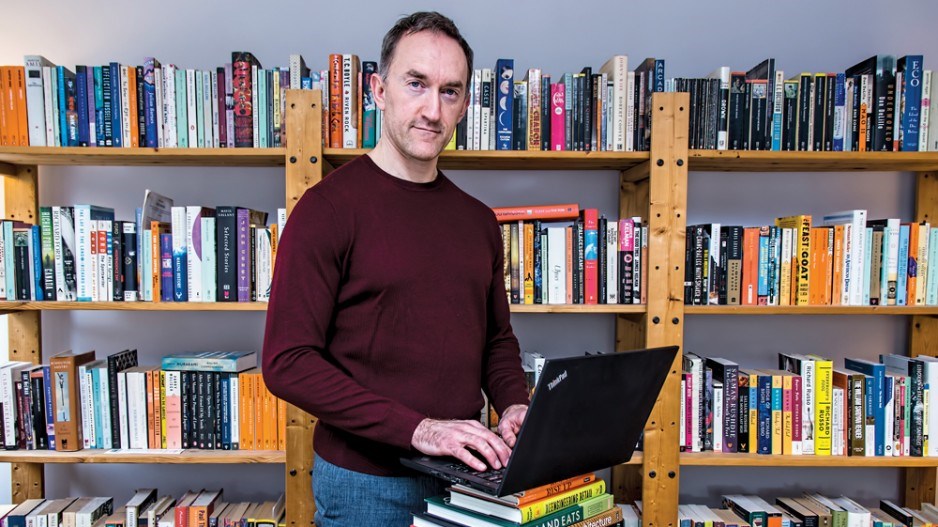The pandemic paralysis that swept over the global economy two years ago left book publishers scrambling.
B.C. bookstores were essentially shuttered for months and major gatherings for international rights sales such as the Frankfurt Book Fair and the London Book Fair were suspended, leaving the broader industry to stitch together a strategy based on best guesses.
“The early part of 2020 was definitely a challenge,” said Chris Labonté, president and publisher of Vancouver-based Figure 1 Publishing Inc.
His hybrid book publishing company focuses significantly on high-end illustrated titles dedicated to everything from restaurants to art galleries.
“Those are the two … components of our economy that were hit the worst, and so we had six or seven books that had to be postponed immediately,” Labonté recalled.
But as the lights turned on in more tourist attractions, restaurants and book stores, sales began taking a turn by January 2021 and have been regaining ground since then.
“This will be our biggest year in terms of number of titles published in the market,” Labonté said, adding 30 books are set for 2022. “It’s 50 per cent greater than our biggest year [previously].”
This big bounce back in business is benefiting another hybrid publisher that also emerged in B.C. after Vancouver’s D&M Publishers Inc. filed for bankruptcy protection in 2012.
“We actually grew our staff in our program considerably,” said Jesse Finkelstein, co-founder and principal of Vancouver’s Page Two Books Inc. Her company now has about 20 people on staff and about a dozen freelance associates, while the past few years has seen it add an audiobook production program and a new global distribution program to the business.
Like Labonté, Finkelstein and her business partner, Trena White, founded their respective hybrid publishing companies in the wake of D&M’s demise.
Definitions of hybrid publishing vary but the business model typically sees publishers working on a fee-for-service basis after selecting manuscripts submitted to them by potential authors. Hybrid publishers generally provide support for distribution and marketing of the books they choose to publish.
The traditional model sees authors licensing their publishing rights to publishers who in turn invest in the project upfront. After receiving an advance, authors are subsequently paid through royalties generated through book sales (hybrid authors can also receive royalties).
Authors must grant a greater degree of creative control to traditional publishers. But the infrastructure backing the project – from editors to distribution – is extensive.
Self-publishing allows authors more creative control but they do not have access to the same distribution and marketing expertise as professional publishers. Getting shelf space in book stores is also generally challenging for self-published authors who must also carry all the financial burden.
But many self-published authors have hit it big.
Fifty Shades of Grey was originally self-published, and earlier this year sci-fi and fantasy writer Brandon Sanderson raised US$15.4 million in just one day to fund four new books he will self-publish.
Back in 2012, Labonté had been developing a hybrid model specifically for traditional publisher D&M when it filed for bankruptcy protection in a bid to restructure.
“I was suddenly out of a job and so I went to a couple of my colleagues from Douglas and McIntyre, who were also out of a job, and we started Figure 1,” he said.
From there, the team set up distribution networks in Canada and the U.S., and built a marketing and publicity arm to support the authors they chose to work with, covering everything from illustrated cookbooks to titles focused on interior design.
Authors may generate revenue through direct sales by going on speaking tours and selling their books to audiences, while also relying on royalties coming in through sales at book stores.
Canada’s book publishing industry was worth $1.7 billion 2021, with Ontario accounting for two-thirds ($1.1 billion) of that figure, according to Ontario Creates, the agency responsible for promoting that province’s creative sectors.
“The centre of publishing in the country is seen as Toronto and so I think there’s maybe a little bit more innovation that happens in Vancouver,” Labonté said.
Finkelstein echoed her former colleague’s sentiments.
“Being on the outside, it sometimes makes you have to be even more creative, even more thoughtful and strategic than you otherwise would be,” said Finkelstein, whose company’s top three bestselling books have sold more than two million copies. “There’s no resting on our laurels.”
She and White, also former colleagues at D&M, launched Page Two after realizing they shared a vision for the type of authors they wanted to work with, according to Finkelstein. The company releases between 50 and 70 titles per year and is among the largest employers in B.C.’s publishing industry.
“We have a very high volume of inquiries and we take on very few projects, so we have a very rigorous curation process. We still determine what kinds of books to publish based on who we feel we can serve well,” Finkelstein said.
But at the outset of the pandemic, Page Two expanded its scope and began acquiring projects typically out of its mandate.
“It immediately diversified our program and therefore also ensured our sustainability,” Finkelstein said. “Once the global landscape began to normalize, and people started to adapt and adjust to pandemic life … we were able to resume our regular operations.”
Labonté said that although he and his former colleagues’ company compete in some categories within the hybrid publishing space, he still considers both to be among the best in North America.
“What’s really set Figure 1 and Page Two apart is that we entered into the hybrid space with all of the experience – years of experience – of traditional trade publishing. A lot of hybrid operations are individuals coming from either journalism, or marketing or some non-book-publishing space,” he said.
“What sets us apart in terms of quality, in terms of the editing, design and the understanding of the entire industry, is that we come from trade publishing.” •




